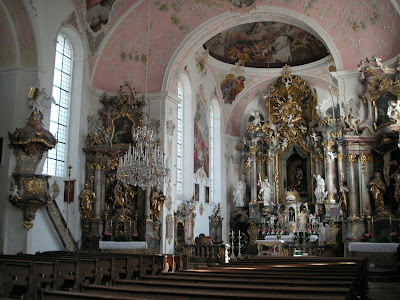Bavarian Baroque I

Bavaria is full of outstanding churches - often very old foundations which were rebuilt or redecorated in the baroque period (partly a reaction to the devastation of the Thirty Years War). Staid Anglo-Saxons are often dismissive of this style (especially Victorian tourists) but I find it fully 'incarnational,' a feast for the eyes, mind and heart. In the memorable words of art historian, John Bourke:
A great multitude of figures and groups surrounds the visitor in one of these churches. He sees saints and prophets and Fathers of the Church at decisive points of vantage, significantly poised and with their appropriate attributes. He sees angels and putti flying, sitting, leaning, supporting, listening, adoring, pointing, reproving, on altar and pulpit, organ and confessional, making jubilant music, bearing emblems of the Betrayal or the Crucifixion, bringing messages from on high, in charge of the mounting horses of Elijah’s fiery chariot, attending the crucified and awaiting the risen Saviour, up-bearing the Virgin at her Assumption. He sees symbols of dogma and doctrine – of the Trinity (a triangle); of the all-seeing eye of God (an eye, usually framed in the triangle), of the self-sacrificing love of Christ (a lamb or a pelican), of his wounded heart (a heart clasped by a crown of thorns), of the Annunciation of the Virgin (a lily) or of her sorrows (a sword or swords piercing her bosom), of the revelation of divine mysteries (a curtain over choir arch, altar or pulpit drawn aside by putti); of the transitoriness of mortal things (a clock), and of much else.The pictures above and below illustrate this well. They were taken in the former Augustinian church of Rottenbuch: a late fifteenth century basilica redecorated in the mid eighteenth century by Josef Schmutzer.
Incidentally, the Augustinian house at Rottenbuch was founded by Duke Welf IV (I of Bavaria) in 1073 (see picture below). He was the brother-in-law of William the Conqueror and is also regarded as the founding father of the House of Hanover (a junior branch of the House of Welf). The Hanoverian George II was reigning in England while his ancestor's Catholic foundation at Rottenbuch was being baroqued up - I don't think he would have approved!

Another magnificent church, also formerly Augustinian, is the Marienmunster at Dießen, situated on the Ammersee.


Even humble village churches share in this splendour - such as the parish church of Oberammergau, dedicated to SS Peter and Paul.

Here's a fine fresco at Oberammergau of St Gregory the Great, one of the four Latin Doctors of the Church:

And an interesting fresco by Gunther above the choir gallery of the view from the confessio at St Peter's, Rome, looking up to Bernini's baldacchino. Now that's what I call communion with Rome:


Labels: Bavaria




8 Comments:
the 2nd pic looks like it was taken in heaven. i guess that was the point, right?
I absolutely love barogue - I attend the very barogue church of St. Agnes in St. Paul, Minnesota. Thank you for the photos.
Beautiful!
The rich symbolism of baroque art not only helps you understand your faith by connecting important contents to plain pictures. At its best, it really does make you feel like you are in Heaven. Surrounded by so many Saints, so many Angels, so much jubilation and praise. I have been to Dießen and lots of other wonderful baroque churches and it works almost every time.
Thanks for this great post
Wow! No wonder The Faith is stronger in Bavaria than the rest of Germany.
Yeesh! I hate to say it, father, but I find German Baroque churches simply hideous.
Give me English gothic any old day.
In Germany they have the choice. There are outstandig churches both in the Baroque and Gothic styles. Only think of Cologne or, e.g., the tallest steeple in the world (530 ft) in...
Who knows where it is? :-)
It is in Ulm, of course. Sadly the "Münster" is not a Catholic church anymore. From the beginning this church was kind of a "private project" of the citizens of Ulm. When the "new faith" came they took a poll and of course everybody was in favor of "the freedom of a Chrsitian". So the Ulmer Münster became Protestant in 1530. Directly afterwards building on the church was stopped (I bet it's just a coincidence ;-) ). The spire was completed in 1890.
BEAUTIFUL, SO INSPIRING.
Post a Comment
<< Home